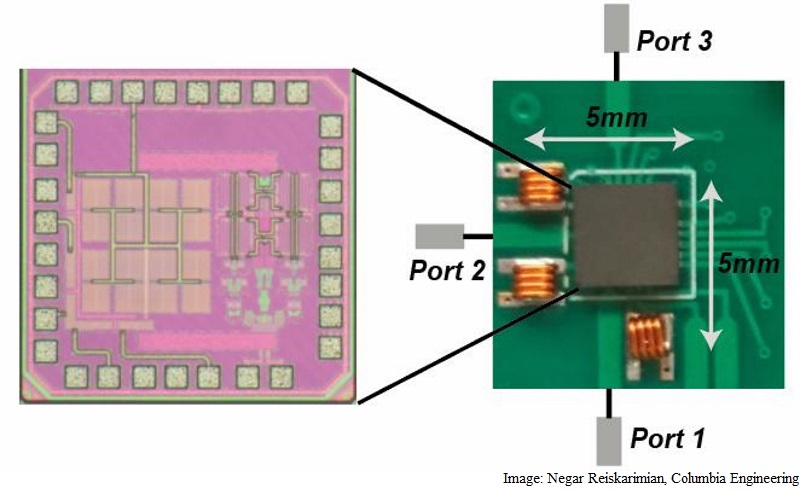- Home
- Internet
- Internet News
- New Wi Fi Technology Can Double Speeds With a Single Antenna: Study
New Wi-Fi Technology Can Double Speeds With a Single Antenna: Study

Researchers have developed a novel technology that can double Wi-Fi speeds with a single antenna, a breakthrough that could revolutionise the field of telecommunications.
This is the first time researchers from Columbia University School of Engineering and Applied Science have integrated a non-reciprocal circulator and a full-duplex radio on a nanoscale silicon chip.
The team, led by Associate Professor Harish Krishnaswamy, developed the technology that needs only one antenna, thus enabling an even smaller overall system.
"This technology could revolutionise the field of telecommunications," said Krishnaswamy, director of the Columbia High-Speed and Mm-wave IC (CoSMIC) Lab.
"Our circulator is the first to be put on a silicon chip, and we get literally orders of magnitude better performance than prior work," said Krishnaswamy.
"Full-duplex communications, where the transmitter and the receiver operate at the same time and at the same frequency, has become a critical research area and now we have shown that Wi-Fi capacity can be doubled on a nanoscale silicon chip with a single antenna. This has enormous implications for devices like smartphones and tablets," he said.
Krishnaswamy's group has been working on silicon radio chips for full duplex communications for several years and became particularly interested in the role of the circulator, a component that enables full-duplex communications where the transmitter and the receiver share the same antenna.
In order to do this, the circulator has to "break" Lorentz Reciprocity, a fundamental physical characteristic of most electronic structures that requires electromagnetic waves travel in the same manner in forward and reverse directions.
"We wanted to create a simple and efficient way, using conventional materials, to break Lorentz Reciprocity and build a low-cost nanoscale circulator that would fit on a chip," said PhD student Negar Reiskarimian, who developed the circulator.
The traditional way of breaking Lorentz Reciprocity and building radio-frequency circulators has been to use magnetic materials such as ferrites, which lose reciprocity when an external magnetic field is applied.
But these materials are not compatible with silicon chip technology, and ferrite circulators are bulky and expensive.
Krishnaswamy and his team were able to design a highly miniaturised circulator that uses switches to rotate the signal across a set of capacitors to emulate the non-reciprocal "twist" of the signal that is seen in ferrite materials.
Aside from the circulator, they also built a prototype of their full-duplex system - a silicon IC that included both their circulator and an echo-cancelling receiver.
The research was published in the journal Nature Communications.
Get your daily dose of tech news, reviews, and insights, in under 80 characters on Gadgets 360 Turbo. Connect with fellow tech lovers on our Forum. Follow us on X, Facebook, WhatsApp, Threads and Google News for instant updates. Catch all the action on our YouTube channel.
Related Stories
- Samsung Galaxy Unpacked 2025
- ChatGPT
- Redmi Note 14 Pro+
- iPhone 16
- Apple Vision Pro
- Oneplus 12
- OnePlus Nord CE 3 Lite 5G
- iPhone 13
- Xiaomi 14 Pro
- Oppo Find N3
- Tecno Spark Go (2023)
- Realme V30
- Best Phones Under 25000
- Samsung Galaxy S24 Series
- Cryptocurrency
- iQoo 12
- Samsung Galaxy S24 Ultra
- Giottus
- Samsung Galaxy Z Flip 5
- Apple 'Scary Fast'
- Housefull 5
- GoPro Hero 12 Black Review
- Invincible Season 2
- JioGlass
- HD Ready TV
- Laptop Under 50000
- Smartwatch Under 10000
- Latest Mobile Phones
- Compare Phones
- Redmi Note 15 5G
- Redmi Note 15 Pro 5G
- Redmi Note 15 Pro+ 5G
- Lava Play Max
- Poco C85 5G
- Honor Magic 8 Lite
- Jolla Phone
- Realme P4x 5G
- Asus ProArt P16
- MacBook Pro 14-inch (M5, 2025)
- OnePlus Pad Go 2
- Poco Pad M1
- Just Corseca Skywatch Pro
- Honor Watch X5
- Acerpure Nitro Z Series 100-inch QLED TV
- Samsung 43 Inch LED Ultra HD (4K) Smart TV (UA43UE81AFULXL)
- Asus ROG Ally
- Nintendo Switch Lite
- Haier 1.6 Ton 5 Star Inverter Split AC (HSU19G-MZAID5BN-INV)
- Haier 1.6 Ton 5 Star Inverter Split AC (HSU19G-MZAIM5BN-INV)

















